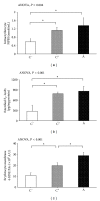Erythrocyte shape abnormalities, membrane oxidative damage, and β-actin alterations: an unrecognized triad in classical autism
- PMID: 24453417
- PMCID: PMC3880759
- DOI: 10.1155/2013/432616
Erythrocyte shape abnormalities, membrane oxidative damage, and β-actin alterations: an unrecognized triad in classical autism
Abstract
Autism spectrum disorders (ASDs) are a complex group of neurodevelopment disorders steadily rising in frequency and treatment refractory, where the search for biological markers is of paramount importance. Although red blood cells (RBCs) membrane lipidomics and rheological variables have been reported to be altered, with some suggestions indicating an increased lipid peroxidation in the erythrocyte membrane, to date no information exists on how the oxidative membrane damage may affect cytoskeletal membrane proteins and, ultimately, RBCs shape in autism. Here, we investigated RBC morphology by scanning electron microscopy in patients with classical autism, that is, the predominant ASDs phenotype (age range: 6-26 years), nonautistic neurodevelopmental disorders (i.e., "positive controls"), and healthy controls (i.e., "negative controls"). A high percentage of altered RBCs shapes, predominantly elliptocytes, was observed in autistic patients, but not in both control groups. The RBCs altered morphology in autistic subjects was related to increased erythrocyte membrane F2-isoprostanes and 4-hydroxynonenal protein adducts. In addition, an oxidative damage of the erythrocyte membrane β-actin protein was evidenced. Therefore, the combination of erythrocyte shape abnormalities, erythrocyte membrane oxidative damage, and β-actin alterations constitutes a previously unrecognized triad in classical autism and provides new biological markers in the diagnostic workup of ASDs.
Figures




Similar articles
-
Non-protein-bound iron and 4-hydroxynonenal protein adducts in classic autism.Brain Dev. 2013 Feb;35(2):146-54. doi: 10.1016/j.braindev.2012.03.011. Epub 2012 Apr 23. Brain Dev. 2013. PMID: 22534237
-
Oxidative Stress in Autistic Children Alters Erythrocyte Shape in the Absence of Quantitative Protein Alterations and of Loss of Membrane Phospholipid Asymmetry.Oxid Med Cell Longev. 2018 Nov 11;2018:6430601. doi: 10.1155/2018/6430601. eCollection 2018. Oxid Med Cell Longev. 2018. PMID: 30607218 Free PMC article.
-
Morphological changes and oxidative damage in Rett Syndrome erythrocytes.Biochim Biophys Acta. 2012 Apr;1820(4):511-20. doi: 10.1016/j.bbagen.2011.12.002. Epub 2011 Dec 13. Biochim Biophys Acta. 2012. PMID: 22183031
-
Red blood cells in Rett syndrome: oxidative stress, morphological changes and altered membrane organization.Biol Chem. 2015 Nov;396(11):1233-40. doi: 10.1515/hsz-2015-0117. Biol Chem. 2015. PMID: 26040005 Review.
-
The Effect of Sepsis on the Erythrocyte.Int J Mol Sci. 2017 Sep 8;18(9):1932. doi: 10.3390/ijms18091932. Int J Mol Sci. 2017. PMID: 28885563 Free PMC article. Review.
Cited by
-
Alterations in Antioxidant Status and Erythrocyte Properties in Children with Autism Spectrum Disorder.Antioxidants (Basel). 2023 Nov 28;12(12):2054. doi: 10.3390/antiox12122054. Antioxidants (Basel). 2023. PMID: 38136174 Free PMC article.
-
Association between alcohol-induced erythrocyte membrane alterations and hemolysis in chronic alcoholics.J Clin Biochem Nutr. 2017 Jan;60(1):63-69. doi: 10.3164/jcbn.16-16. Epub 2016 Oct 5. J Clin Biochem Nutr. 2017. PMID: 28163384 Free PMC article.
-
Exploring unconventional attributes of red blood cells and their potential applications in biomedicine.Protein Cell. 2024 May 7;15(5):315-330. doi: 10.1093/procel/pwae001. Protein Cell. 2024. PMID: 38270470 Free PMC article. No abstract available.
-
The chromatin remodeler CHD8 governs hematopoietic stem/progenitor survival by regulating ATM-mediated P53 protein stability.Blood. 2021 Jul 22;138(3):221-233. doi: 10.1182/blood.2020009997. Blood. 2021. PMID: 34292326 Free PMC article.
-
Acanthocytes Identified in Huntington's Disease.Front Neurosci. 2022 Jun 6;16:913401. doi: 10.3389/fnins.2022.913401. eCollection 2022. Front Neurosci. 2022. PMID: 35733931 Free PMC article.
References
-
- Herbert MR. Contributions of the environment and environmentally vulnerable physiology to autism spectrum disorders. Current Opinion in Neurology. 2010;23(2):103–110. - PubMed
-
- Fombonne E. Is there an epidemic of autism? Pediatrics. 2001;107(2):411–413. - PubMed
-
- Baio J. Prevalence of Autism spectrum disorders: autism and developmental disabilities monitoring network, 14 Sites, United States, 2008. Morbidity and Mortality Weekly Report. 2012;61(3):1–19. - PubMed
-
- Weintraub K. The prevalence puzzle: autism counts. Nature. 2011;479(7371):22–24. - PubMed
Publication types
MeSH terms
Substances
LinkOut - more resources
Full Text Sources
Other Literature Sources
Miscellaneous

